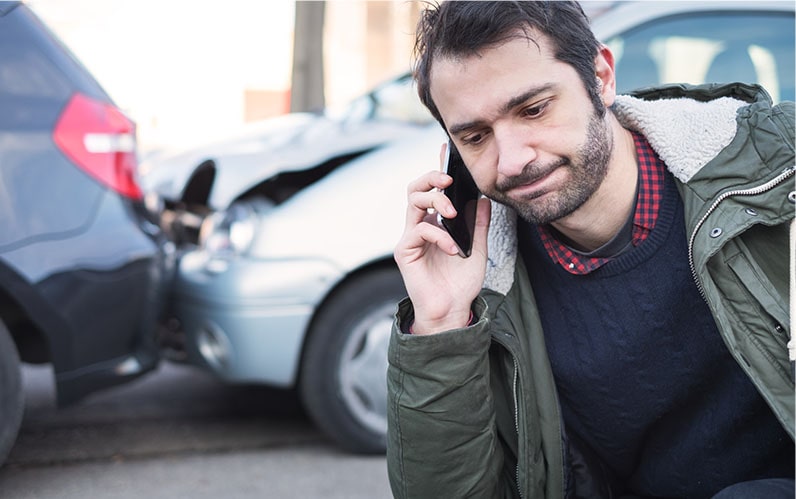Is It a Criminal Offence to Leave the Scene of a Fender Bender?
I was involved in a fender bender, where I hit another car at a stop light. I was on my way to the airport and couldn’t stay so I told the person I had to go and would contact them. Is it a criminal offence to leave this type of accident?
This question is one that we often get asked in various forms. In order to properly address it, it is important to know the various obligations that exist for conduct relating to these types of offences. And also, on the subject of “these types of offences,” it is important to observe that these offences are not, strictly speaking, driving offences. Rather, they are what are known as offences against the administration of justice (or justice system offences). Why are these not merely driving offences? First and most obviously, they don’t look at conduct that happens while driving, but rather conduct which occurs after driving ceases [as a result of an accident]. More importantly, what gives them their nature as relating to how the justice system works is that they (and the obligations related to them) play a very important role in ensuring that accidents are properly documented by drivers and investigated by police. Many accidents are – as their name implies – merely accidents, but many accidents are avoidable, giving rise to civil fault which could be relevant to insurance companies or in civil/small claims court. Furthermore, some accidents are caused not only by civil fault, but by the failure to abide by rules of the road (following too closely, changing lanes unsafely, driving carelessly, etc.). And some accidents are the result of criminal conduct including impairment by alcohol or by drugs. In order for society to function effectively, the police need to be able to properly investigate things like this. And for the police to properly investigate, people involved in motor vehicle accidents need to stop, remain, identify themselves, and where appropriate, report the accident.
We will now discuss the obligations in the order of least serious to most serious of their related offences:.
1. Failing to Report an Accident
Located in Part XIV of the Highway Traffic Act of Ontario is the part dealing with “Records and Reporting of Accidents and Convictions”. Within it is Section 199. It reads:
Duty to report accident
199 (1) Every person in charge of a motor vehicle or street car who is directly or indirectly involved in an accident shall, if the accident results in personal injuries or in damage to property apparently exceeding an amount prescribed by regulation, report the accident forthwith to the nearest police officer and furnish him or her with the information concerning the accident as may be required by the officer under subsection (3). R.S.O. 1990, c. H.8, s. 199 (1); 2002, c. 17, Sched. F, Table.
You will notice the word “apparently” and the phrase “prescribed by regulation.” In order to interpret this, please consider the Ontario Regulation called “General, RRO 1990, Reg 596.” In it, they discuss the specifics regarding “Damage to Property Accident Reports.” At Section 11, it reads:
11. For the purpose of subsection 199 (1) of the Act, the prescribed amount for damage to property is $2,000. O. Reg. 537/97, s. 1; O. Reg. 228/15, s. 1. 11.
Once you know this, you then consider the word “apparently.” What that means is that the damage needs to “appear” to be more than $2,000. It has little to do with the actual amount of the damage. This, of course, is very subjective but it is rooted in common sense. Firstly, even the actual damage is subject to different opinions as to what it could be – so that method of evaluation would not be much easier to interpret. Most importantly, the apparent damage is what matters for the purpose of someone’s moral and legal obligation to report the accident. If someone were to lightly scratch a car unaware that the bump caused serious damage to an internal electronics system, it would make sense that they wouldn’t expect the damage to be that much. Essentially, there is an objective analysis of what the damage appears to be. If most people would agree that the damage appears to be over $2000, then the obligation to report is triggered even if it turns out that the damage is less. Obviously, the actual amount of the damage is relevant to what most people would agree the damage appears to be. If the bill comes back as $5000 and there wasn’t anything particularly hidden, it may be difficult for you to say it looked – to you – like it was less than $2000. Note well that no matter what the damage or apparent damage is, if there is any indication that the accident resulted in injuries to a person, then the obligation to report is triggered.
Before leaving this section, there is also a related section (rarely used though) at Section 201 of the Highway Traffic Act:
Notification of damage to trees, fences, etc.
201 Every person who, as a result of an accident or otherwise, operates or drives a vehicle or leads, rides or drives an animal upon a highway and thereby damages any shrub, tree, pole, light, sign, sod or other property on the highway or a fence bordering the highway shall forthwith report the damage to a police officer. R.S.O. 1990, c. H.8, s. 201.
It basically says the same thing as section 199, only there is no quantum. Any damage to a shrub, tree, pole, light, sign, sod, or property or fence on the highway needs to be reported.
“Forthwith” is used in both instances and means doing it right away. Whether or not something is forthwith is contextual. There are too many variables to discuss this now, but if you have been involved in an accident and are concerned you may be on the cusp of what is forthwith, please call David Anber on his cell immediately at 613-276-3283 to get information about this.
2. Failing to Remain at the Scene of an Accident
There is a more serious related provision in the Ontario Highway Traffic Act:
Duty of person in charge of vehicle in case of accident
200 (1) Where an accident occurs on a highway, every person in charge of a vehicle or street car that is directly or indirectly involved in the accident shall,
(a) remain at or immediately return to the scene of the accident;
(b) render all possible assistance; and
(c) upon request, give in writing to anyone sustaining loss or injury or to any police officer or to any witness his or her name, address, driver’s licence number and jurisdiction of issuance, motor vehicle liability insurance policy insurer and policy number, name and address of the registered owner of the vehicle and the vehicle permit number. R.S.O. 1990, c. H.8, s. 200 (1); 1997, c. 12, s. 16.
Penalty
(2) Every person who contravenes this section is guilty of an offence and on conviction is liable to a fine of not less than $400 and not more than $2,000 or to imprisonment for a term of not more than six months, or to both, and in addition the person’s licence or permit may be suspended for a period of not more than two years. 2009, c. 5, s. 54.
So whether or not the accident is subject to reporting requirements, a person is still required to remain at (or if their car has continued down the road a bit, return to) the scene of the accident and render assistance to anybody who needs it as a result of the accident. Also, if anybody has sustained any injuries or damage to their property, you must give the specified information (your name, address, driver’s licence number, and jurisdiction of the driver’s licence, insurance company and policy number, registered owner’s name and address and vehicle permit number) to the person involved and also to a police officer.
As you can see, the penalties are more serious and includes possible jail and possible licence suspensions. The demerit points are higher also (7 versus 3 for failing to report).
3. Failing to Stop (The Criminal Code Equivalent of Failing to Remain)
In December 2018 there were amendments to the Criminal Code of Canada. The most recent version of this offence reads:
Failure to stop after accident
320.16 (1) Everyone commits an offence who operates a conveyance and who at the time of operating the conveyance knows that, or is reckless as to whether, the conveyance has been involved in an accident with a person or another conveyance and who fails, without reasonable excuse, to stop the conveyance, give their name and address and, if any person has been injured or appears to require assistance, offer assistance.
Accident resulting in bodily harm
(2) Everyone commits an offence who commits an offence under subsection (1) and who at the time of committing the offence knows that, or is reckless as to whether, the accident resulted in bodily harm to another person.
Accident resulting in death
(3) Everyone commits an offence who commits an offence under subsection (1) and who, at the time of committing the offence, knows that, or is reckless as to whether, the accident resulted in the death of another person or in bodily harm to another person whose death ensues.
This offence is like the HTA offence of failing to remain, only it is more serious. It occurs in a situation where the person “knows” or “is reckless” to knowing that they have been involved in an accident.
What is interesting is that prior to the changes in December 2018, there was a requirement that the person had the “intent to escape civil or criminal liability.” This requirement is no longer a part of the section and so the section now more closely resembles the HTA provision.
4. The Difference
The difference between these offences is spelled out above with the most notable observation being that the distinction between “fail to remain” under the provincial legislation and “fail to stop” under the criminal code is must smaller than it once was.
David Anber
David Anber has been a trailblazing legal practitioner since 2006. His early entry into law practice during his studies marked the beginning of a distinguished career. As a member of both Ontario and Quebec’s bar associations, David excels in defending traffic and criminal cases across both provinces. David contributes to legal discourse through articles for the Defence Counsel Association of Ottawa and the Criminal Lawyer’s Association of Ontario.

